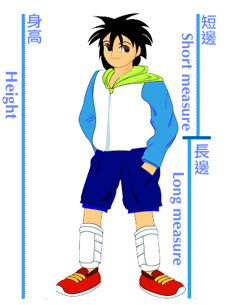| Belly Button Ratios |
|
|
|
|
|
|
|
| __________ Height in inches. |
|
|
|
|
|
|
| __________ Long Measure - The distance from your belly button to the bottom of your foot in inches. |
| __________ Short Measure - The distance from the top of your head to your belly button in inches. |
| __________ First Ratio = height/long measure |
|
|
|
|
| __________ Second Ratio = long measure/short measure |
|
|
|
|
| Put your ratios on the board separated by gender. |
|
|
|
|
| Homework: run hypothesis tests to determine if there is a gender difference. |
|
|
| Note in the small sample size n study below, the differences are not significant. |
|
|
|
|
|
|
|
|
|
|
|
Gender |
First |
Second |
|
Gender |
First |
Second |
|
| Sylvia |
F |
1.66 |
1.58 |
Ertin |
M |
1.6 |
1.66 |
|
| Meranda |
F |
1.69 |
1.46 |
Lee Ling |
M |
1.68 |
1.47 |
|
| Anastasia |
F |
1.67 |
1.49 |
Serafin |
M |
1.65 |
1.23 |
|
| Agnes |
F |
1.61 |
1.8 |
Kevin |
M |
1.63 |
1.58 |
|
| Kesarina |
F |
1.67 |
1.5 |
A-1 |
M |
1.73 |
1.37 |
|
| Carolyn |
F |
1.67 |
1.44 |
|
|
|
|
|
| Kiumy |
F |
1.63 |
1.53 |
|
|
|
|
|
|
|
|
|
|
|
|
|
|
|
n |
7 |
7 |
|
|
5 |
5 |
|
|
mean |
1.6540 |
1.5431 |
|
|
1.6572 |
1.4624 |
|
|
stdev |
0.03 |
0.12 |
|
|
0.05 |
0.17 |
|
|
|
|
|
|
|
|
|
|
|
|
|
|
|
|
|
|
|
|
mean difference |
-0.0032 |
0.0807 |

|
|
|
|
|
|
Ho: µ1-µ2=0 |
|
|
|
Ho: µ1-µ2<>0 |
|
|
| Hyp |
pooled 1/√n |
0.5855 |
0.5855 |
| Test |
degrees freedom |
10 |
10 |
|
pooled s |
0.0382 |
0.1436 |
|
t-statistic t |
-0.1432 |
0.9605 |
|
t critical tc |
2.2281 |
2.2281 |
|
p-value |
0.8890 |
0.3595 |
|
max c |
0.1110 |
0.6405 |
|
|
|
|
| Conf |
Error E |
0.0498 |
0.1873 |
| Int |
mean diff – E |
-0.0530 |
-0.1066 |
|
mean diff |
-0.0032 |
0.0807 |
|
mean diff + E |
0.0466 |
0.2681 |
|
Both include zero: Zero cannot be |
|
ruled out as a possible pop value |
|
|
|
|
| Section 9.4: If n were equal, solve for n. Note that using tc will overestimate n, which is |
|
| considered a "conservative" approach. Better to overestimate than underestimate. |
|
| The desired Error E would be equal to or less than the mean difference. |
|
|
|
|
|
|
|
|
|
|
|
n |
1412.27 |
31.39 |
|
|
|
|
|
|
|
|
|
|
|
|
|
|
| In theory the first and second ratios approach the Fibonacci Ratio: |
|
|
=(1+SQRT(5))/2 |
|
|
|
|
|
|
|
|
1.6180 |
|
|
|
|
|
|
|

